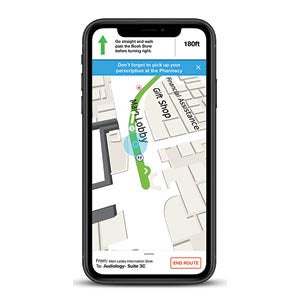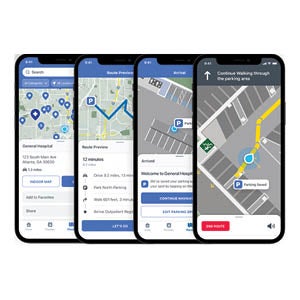Improving navigation with digital wayfinding
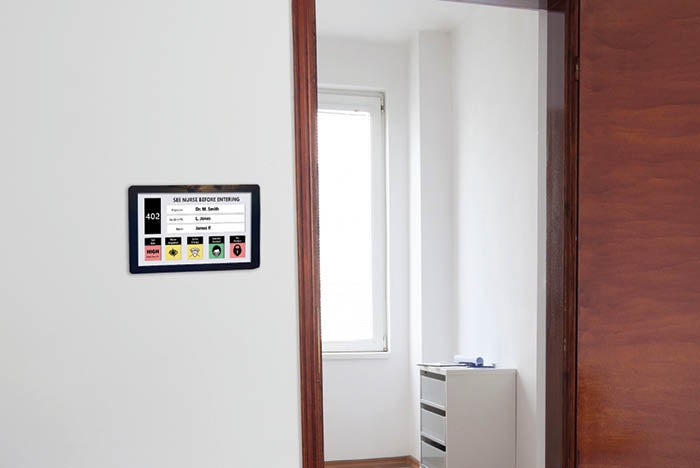
Image from MDM Healthcare
Digital wayfinding systems come in a variety of formats such as wall signage and kiosks to help visitors, patients and staff navigate their way through health care facilities. Thanks to advances in software, the use of mobile solutions also has expanded significantly, helping users find their ultimate destination, a journey that can begin at home and end at a hospital procedure room.
Anticipating needs
Hospitals pose challenges to digital wayfinding vendors. Many health care facilities struggle with basic wayfinding principles as they expand, according to Debbie DeWitt, marketing communications manager at Visix Inc., Atlanta. “Multiple rooms and building systems can be put in place over time, which can confuse visitors and make crafting a digital solution more complicated. It’s essential that a facility has some solid experiential design in place, such as consistent naming conventions and color-coding, so they can match the onscreen wayfinding experience to the on-the-ground experience.”
Vendors also may run into network infrastructure challenges and not enough facilitywide standardization, according to Chase Natoli, director of technical sales at MDM Healthcare, Ponte Vedra Beach, Fla. “A lot of specialized equipment is required to create a seamless wayfinding experience. We’ve found at times there is not enough coordination of standards between health systems and sister facilities. This is where a systems integrator can add value by bridging those communication gaps.”
The best digital wayfinding systems anticipate users’ needs at each stage in their health care journey, according to Joshua Titus, founder and CEO at Gozio Health, Atlanta. “Location-aware technologies create a digital hand-holding experience from patients’ homes to parking to the point of care,” he says. “They also help manage patient throughput by advising at each stage of the journey, from a stop at the front desk to obtain a badge to a trip to patient registration. Every destination is mapped out on their phone from one point to the next, eliminating the stress of navigating a hospital environment.”
Thanks to the use of quick response (QR) codes to obtain directions, hospitals no longer require patients and visitors to download mobile apps. Users can access maps from mobile web browsers, home computers, tablets and kiosks. The ability to print turn-by-turn indoor directions is available to those not inclined to utilize mobile technology. This increased accessibility encourages more adoption, which helps to reduce scheduling delays and improve emergency services.
In addition to the ease of QR code navigation, another advantage of this technology is integration and interoperability, according to Clay Anderson, global product manager of CenTrak Software at CenTrak, Newtown, Pa. “By integrating this patient-centric solution with electronic health records (EHRs), a provider can send text messages with real-time appointment reminders that include parking recommendations, estimated travel time and walking directions.”
The latest digital wayfinding systems also can interface with other health care facility technologies, such as security, real-time location systems (RTLSs), patient education, nurse call and building automation. Asset tracking is an example of an application that often is added on after initial wayfinding needs are met. If critical assets are tagged with a radio frequency transceiver, staff can quickly find wheelchairs, infusion pumps and other mobile assets. Employees can view the asset’s location on the map, ascertain its status and tap the map to navigate to it.
Wayfinding innovations
Among the range of digital wayfinding signage, kiosks and hand-held technologies available to the health care market, CenTrak recently incorporated the use of QR codes into its wayfinding platform, adding a layer of scalability to the CenTrak Maps solution. The digital maps feature highlighted routes, real-time directions and points of interest. “System administrators can create custom pathways, such as employee-only access, or routes for patients and visitors that avoid stairs,” Anderson says. “Users can save their parking location upon arrival and securely share their location with others.”
The Wayfinder solution from Everbridge, Burlington, Mass., provides navigation functionality on mobile devices, the web and kiosks. It also enables customers to build their own mobile solutions either with the Everbridge mobile software development kit or a white label application. This allows patients to integrate wayfinding directly into their appointment reminder, creating an end-to-end contextual experience. “We’ve been working with customers on expanding indoor location services to address additional use cases, including staff safety and security,” says Eric Chetwynd, general manager of health care solutions.
In many cases, Everbridge’s wayfinding solution can work with a health care system’s current beacon and access point infrastructure. In addition, the company offers capabilities that enable users to integrate with building automation including access control, cameras and elevators.
Visix Inc. offers voice-activated wayfinding for a wide range of displays. “Clients using our AxisTV Signage Suite software can build their own interactive layouts with options for voice and touch interaction, or Visix can create a custom solution that’s not reliant on our software,” DeWitt says. Visix custom wayfinding projects are built as responsive HTML5 designs for both large-screen and mobile versions, and many include QR codes and text options to download directions to phones. “We often recommend that a facility use the maps from their website or store the ones we create for them on the web to better bridge visitors’ online and on-site experiences,” DeWitt says.
Cooper Signage & Graphics Inc., Loganville, Ga., offers a variety of touchless interactive displays. Included are low-cost kiosks on which a person can scan a QR code, which takes them to an online visitors’ guide in their desired language featuring maps and directions. Visitors can interact with the kiosk via hand-held devices and receive a hard copy from the information desk.
These units can be updated via a thumb drive or hard-wired for remote access. Also, wall- and desk-mounted units are available for medical office buildings or where floor space is limited. These units can easily replace old-school, strip-type directories.
The company’s emphasis on immersive graphic experiences extends to health care in other ways, including donor recognition programs, according to Randy Cooper, founding partner of Cooper Signage & Graphics. “Utilizing backdrops, static graphics such as dimensional letter plaques and photos work in harmony with digital signage to create a museum-like impact. Donor recognition can incorporate timelines and video for rich texture and interesting effects.”
MDM Healthcare provides digital signage and wayfinding solutions that include 3D mapping, augmented reality (AR), point-to-point navigation and QR codes. “Recent solutions center on small form factor displays, which can be placed outside of the patient room,” Natoli says. “This Digital Door Sign solution integrates with our Journey PX patient engagement platform to provide key patient information to the care team and loved ones before they enter the room.”
MDM’s Journey PX patient engagement platform can interface with RTLS, nurse call, building automation, security and patient education. “For example, when a care team member uses their badge to enter a patient room, the RTLS will automatically pull up the patient’s care information provided by the hospital’s EHR platform on a digital whiteboard display,” Natoli says.
22Miles, Milpitas, Calif., helps many health care facilities achieve their wayfinding goals, according to Kathy Isaacs, regional manager. “With our Secure Mobile Control solution, users can scan QR codes on kiosks, video walls, screens or traditional print signs to bring interactive content to their screens via a web browser or native application designed by the facility. This gives them access to interactive directions and content for navigating the facility at their fingertips.” This not only achieves hygiene goals by removing the need for touch screens, it delivers a solution that lasts throughout the patients’ stay at the hospital.
Because every health care facility is different, customization is key when implementing solutions that often include different product mixes and levels, Isaacs says. “From premium wayfinding solutions that include AR, pop-up technology, events and directory details to simple solutions that integrate into existing hardware, there’s always a solution that will help get patients and staff to where they need to be.”
Inpixon, Palo Alto, Calif., works with many health care facilities and has introduced indoor intelligence solutions that include interactive map kiosks as well as mobile apps with blue dot, turn-by-turn navigation and asset tracking. “Most of our clients initially seek our services for wayfinding capabilities and navigation, but we work with them to create new ways to apply the full range of available technologies to work for their specific needs,” says Nadir Ali, CEO.
One successful Inpixon integration enables data flow and triggers between wayfinding maps and a facility’s EHR or appointment booking system. This enables at-home patients to click on their appointment details by email and get driving directions to the appropriate parking structure, to the right building entrance and to their final destination.
Gozio Health offers a mobile wayfinding platform that can interface with other digital technologies, ranging from online scheduling to the ability to view wait times at urgent care centers to virtual care and bill payment. “During the pandemic, University Health in San Antonio equipped its mobile app with the ability to deliver real-time push notifications to residents’ smartphones,” Titus says. “This gave users access to virtual triage and real-time information on health system hours, protocols and wait times. It also enabled the health system to easily convey large-scale operational changes, such as when visitor restrictions were put in place to prevent the spread of COVID-19.”
2/90 Sign Systems, Grand Rapids, Mich., recently implemented a digital signage system at the Pittsburgh VA Medical Center that features single-screen and multiscreen displays throughout two primary care buildings. The system was set up on an independent, self-contained network, allowing the facility to update and monitor the digital signage system without interfering with other hospital systems and networks.
“Custom enclosures were built to exacting specifications for a sure fit in the existing environment with design elements that integrate the digital signage seamlessly with the 2/90 architectural signage program,” says Chris Douma, president. “The digital signage system is used to communicate important wayfinding instructions and real-time health care service information to patients, visitors and staff.”
Looking ahead
What advances do vendors see ahead for digital health care wayfinding technologies?
Emerging technology will evolve and link with apps as two-way communicative tools, says Cooper, who offers this scenario: “You are driving your spouse to chemo treatment and your phone tells you to use a different parking garage because the main one is full. At the same time, a signal is sent to the oncology center that you are arriving so your spouse’s treatment can begin without delay upon arrival.”
Ali predicts that 3D maps with artificial intelligence-enabled AR will unleash a host of benefits that will be used to save time and money and improve patient care upon arrival.
“Imagine, for instance, caregivers wearing AR smart glasses, and viewing patient history and medical status on their heads-up displays, presented with the latest information in real time, thus freeing their hands for tasks more critical than holding a chart, tablet or phone.”
Neal Lorenzi is a freelance writer and regular contributor based in Mundelein, Ill.

VERY VERSATILE
This multi-use display at the Pittsburgh VA Medical Center integrates an interactive directory, visual directions and detailed information to ensure successful navigation of the facility reinforced with static signage. 2/90 Sign Systems
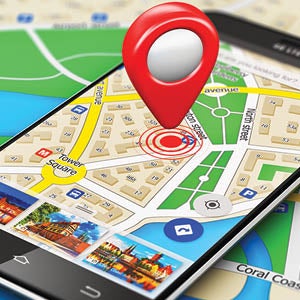
CLEAR AND CONFIDENT
Clear wayfinding instructions to and around health care facilities can instill confidence in patients to reach their destinations without stress. 22Miles

FOLLOW ALONG
This point-to-point digital wayfinding system offers blue dot, turn-by-turn navigation apps. Inpixon

SIMPLIFIED DIRECTIONS
Real-time, on screen, global positioning system-type interior wayfinding provides directions even within complex, multistory facilities. Cooper Signage & Graphics Inc.

IMPRESSIVE OPTIONS
Custom wayfinding designs offer multilingual, QR, text and print options for visitors. Visix Inc.
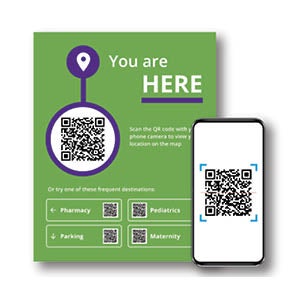
SCANNING THE WAY
Users scan the QR code with a mobile device, choose a destination from the facility’s digital directory and receive turn-by-turn navigation. Centrak

EARLY NOTICE
The Digital Door Sign provides care team members with vital patient information before they enter the room. MDM Healthcare
Neal Lorenzi is a Mundelein, Ill.-based contributor to Health Facilities Management.


